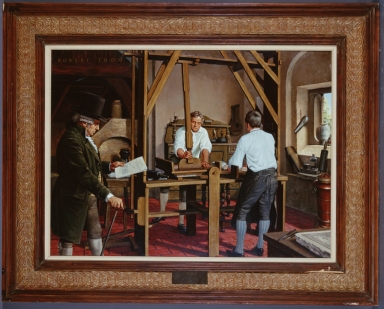|
REFINE
Browse All : Printing presses - History and Printers - Germany by Thom, Robert A., 1915-1979 of Germany - Munich
1-2 of 2
Title
Alois Senefelder and Lithography
Creator
Thom, Robert A., 1915-1979
Summary
Near the close of the century, a young Bavarian playwright named Alois Senefelder sought a method of printing his own plays. His first efforts were engraved and etched on copper and printed on a makeshift intaglio press. The high cost of copper led Senefelder to experimentation with limestone slate. In 1796, a happy accident occurred. Having no paper immediately at hand, Senefelder wrote out an urgently needed laundry list on a polished piece of stone with a greasy ink mixture. Curiosity led him to the discovery that it was not necessary for the printing surface to be raised in the usual manner. The greasy image surrounded by the water-attracting stone surface accepted ink, while the dampened part of the stone rejected it. Printing from a plane or level surface, of lithography as we know it was born. Pursuing his discovery, Senefelder succeeded in adapting his process to metal plates by 1803.
Title
Alois Senefelder and Lithography
Creator
Thom, Robert A., 1915-1979
Summary
Near the close of the century, a young Bavarian playwright named Alois Senefelder sought a method of printing his own plays. His first efforts were engraved and etched on copper and printed on a makeshift intaglio press. The high cost of copper led Senefelder to experimentation with limestone slate. In 1796, a happy accident occurred. Having no paper immediately at hand, Senefelder wrote out an urgently needed laundry list on a polished piece of stone with a greasy ink mixture. Curiosity led him to the discovery that it was not necessary for the printing surface to be raised in the usual manner. The greasy image surrounded by the water-attracting stone surface accepted ink, while the dampened part of the stone rejected it. Printing from a plane or level surface, of lithography as we know it was born. Pursuing his discovery, Senefelder succeeded in adapting his process to metal plates by 1803.
1-2 of 2
|

